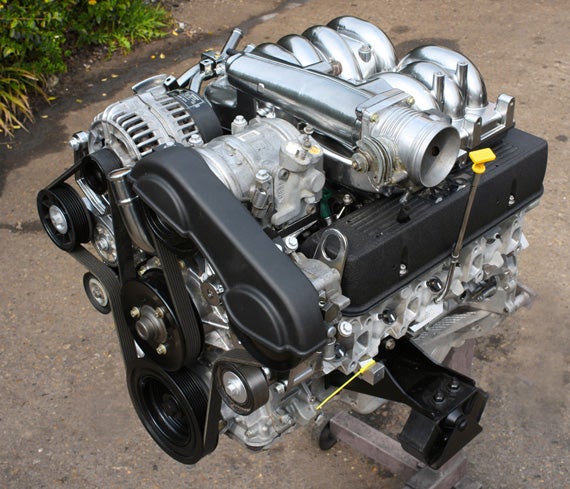 by "RamblinRover Luxury-Yacht" (ramblininexile)
by "RamblinRover Luxury-Yacht" (ramblininexile)
Published 03/03/2017 at 10:40
 by "RamblinRover Luxury-Yacht" (ramblininexile)
by "RamblinRover Luxury-Yacht" (ramblininexile)
Published 03/03/2017 at 10:40
No Tags
STARS: 2
Aperson had
an interesting thread
back on Monday, but Iíd like to revisit it. A long stroke means either that you have a Euro steam horse tax scheme engine, a tractor engine, or an engine thatís big - but a short stroke (potentially) means ďTEH REVS, MANGĒ. How low can you go?
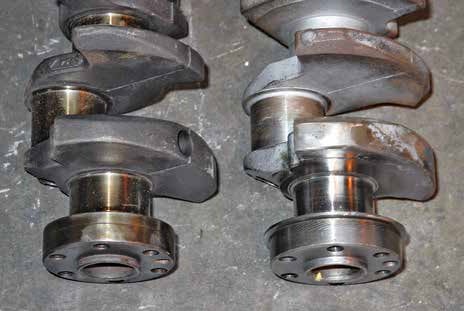
Thread inspired by the small-block Ford, because as low as 2.87".
 "jimz" (jimz)
"jimz" (jimz)
03/03/2017 at 10:45, STARS: 3
the limiting factor is the ratio of the length of the connecting rod to the radius of the crank swing, as that defines the peak piston speed for a given RPM.
 "MontegoMan562 is a Capri RS Owner" (montegoman562)
"MontegoMan562 is a Capri RS Owner" (montegoman562)
03/03/2017 at 10:51, STARS: 0
My stock-stroke Ford 302 in the Rally Capri is 3".
Itís all about the stroke on the Small Block Ford though, the 289 is your 2.87 and you can get a wild 347 Stroker motor with a 3.4"
 "RamblinRover Luxury-Yacht" (ramblininexile)
"RamblinRover Luxury-Yacht" (ramblininexile)
03/03/2017 at 10:54, STARS: 0
Yep. There is definitely a difference between a tall deck engine with short stroke and a shorter deck engine with short stroke and a very low rod:stroke. However, for the purposes of this discussion, weíre not looking at rod:stroke because the original post didnít.
 "RamblinRover Luxury-Yacht" (ramblininexile)
"RamblinRover Luxury-Yacht" (ramblininexile)
03/03/2017 at 10:56, STARS: 0
I have what is alleged to be a 289 in my Galaxie (and is either a 289 or 260), which means I am oversquare as HEIALLL.
 "Alfalfa" (alfalfa-romeo)
"Alfalfa" (alfalfa-romeo)
03/03/2017 at 10:59, STARS: 0
3.5" in my 351 small block.
 "SidewaysOnDirt still misses Bowie" (sidewaysondirt)
"SidewaysOnDirt still misses Bowie" (sidewaysondirt)
03/03/2017 at 11:03, STARS: 0
Yep, and this is why I want a Mazda K8 so bad. 2.01 rod ratio! B series engines are like 1.74 and the F20 is 1.82.
 "Maxima Speed" (maximaspeed)
"Maxima Speed" (maximaspeed)
03/03/2017 at 11:04, STARS: 0
3.3 inch stroke in the Solara.
 "If only EssExTee could be so grossly incandescent" (essextee)
"If only EssExTee could be so grossly incandescent" (essextee)
03/03/2017 at 11:08, STARS: 0
My old Metro had a stroke of 2.97in. My current 528i is†a perfectly square 3.3inx3.3in design, but the two liter version has a ridiculous 2.6in stroke
 "RamblinRover Luxury-Yacht" (ramblininexile)
"RamblinRover Luxury-Yacht" (ramblininexile)
03/03/2017 at 11:12, STARS: 0
The 2.87 in my 289 gives it a rod:stroke ratio of 2.28, which is ridankulous.
EDIT: I apparently entered numbers wrong and my coffee isnít working. Stupid cold.
 "Snuze: Needs another Swede" (markg)
"Snuze: Needs another Swede" (markg)
03/03/2017 at 11:12, STARS: 5
JimZ is absolutely right, the ďrod ratioĒ is important, though not in and of itself. Peak piston speed is important in that it relates to piston acceleration. Think of a piston moving down the bore on the power stroke. Reaching the bottom it has to come to a stop (for a miniscule amount of time) and reverse direction and begin moving back up the bore. At the top and bottom of the bore (when speed is zero) weíre seeing maximum piston acceleration, and in the middle of the bore we see maximum speed but no acceleration. The faster the piston is moving in the bore, the more acceleration it will see as it changes direction, so a longer rod ratio is ideal because it lowers speed which in turn positively impacts acceleration. Note that too long of a ratio can be detrimental as you run into issues of rod arm angularity, excessive span, etc. Additionally, recall that F=MA, so mass is also important, reducing mass reduces the total force seen by the piston. I think the reason people get hung up on stroke is that this was a very real concern in early engines, higher revving and/or longer stroke engine put more stress on pistons and wrist pins and it was very possible to let one go. Fortunately, modern materials science mostly can overcome these limitations (within reason), so weíre seeing the limitations on absolute RPMs come from other places.
Delving further into the rotating assembly, you need to look at things like oiling, windage, and bearing speeds. Oil is crucial, we all know that, but maintaining oil control is supremely important at high RPM. You need the right about of oil pressure in your bearings to keep everything gliding along. You also need to control oil in the sump via a windage tray, and/or crank scraper, or use a dry sump system, so that the crank throws are not being doused in oil. This is especially important in road racing cars that are going to see oil sloshing around the pan a lot. Lastly, bearing speed is important. Reducing the journal sizes of the crank means smaller bearing diameters which means lower bearing speed as they rock back and forth on the journal. This puts less shear stress on the oil film and minimizes your chances of wiping a bearing. The trade off is smaller journals are weaker, so see above. Lastly, tangentially related, is controlling bay-to-bay breathing. Another reason dry sumps shine in high RPM applications, aside from oil control, is they generate a vacuum in the crank case. Otherwise you have a big olí blob of air down there being constantly compressed and expanded, pushed back and forth, by the up and down motions of the pistons. This isnít itself a limiting factor to RPM, but it is a high RPM power robber.
Moving beyond the bottom end, Iíd argue that the limiting factors for RPM is actually in the top end, namely cam and valve control. If you look into the world of exotic engines like Formula 1, they are using air ďspringsĒ instead of traditional steel valve springs. The reason is their resonant frequency is so much higher than a steel spring. As engine speed increases and you approach the resonant frequency of the spring-mass assembly that is the valve and spring (plus pushrod and lifter if youíre talking about that kind of engine), the spring loses itís ability to maintain positive control of the valve, keeping the lifter and/or follower seated on the cam. In mild cases this leads to a chattering effect where the valves bounce off their seats, which hurts cylinder pressure, as well as leads to damage over time. In extreme cases, you float the valve which leads to little to no compression (best case in this bad situation) or piston to valve contact and a severely damaged engine.
 "RamblinRover Luxury-Yacht" (ramblininexile)
"RamblinRover Luxury-Yacht" (ramblininexile)
03/03/2017 at 11:12, STARS: 0
Ford 289: 2.87 stroke, 5.15 rod, => 1.79
 "SidewaysOnDirt still misses Bowie" (sidewaysondirt)
"SidewaysOnDirt still misses Bowie" (sidewaysondirt)
03/03/2017 at 11:17, STARS: 0
More like 1.79
 "RamblinRover Luxury-Yacht" (ramblininexile)
"RamblinRover Luxury-Yacht" (ramblininexile)
03/03/2017 at 11:20, STARS: 0
Thanks for putting all this here so I didnít have to. (Hint, I have a BSME). Iím familiar with this stuff, but a lot of people arenít, and much like Apersonís post, this one is more about ďfind the extreme limit numberĒ, with my characterization limited to layman scope/Ēpopular wisdomĒ on purpose.
Iím in the middle of planning for a performance Rover V8, for which Iím right up against limits on stock valvetrain and really need to go to improved pushrods *and* rockers - at the same time, Iím keeping journal size down and limiting stroke by my choice of crank and oil pressure up by my choice of pump/timing cover setup, with rod ratio improved by a change in pistons and rods... unfortunately, some of the crank size Iíve got are vibration sensitive and there isnít a forged alternative available. I wonít know if mine has a weak spot in it until I try. WHEEE. Probably ought to magnaflux as a precaution.
 "RamblinRover Luxury-Yacht" (ramblininexile)
"RamblinRover Luxury-Yacht" (ramblininexile)
03/03/2017 at 11:21, STARS: 0
I CAN CALCULATOR. Clearly I entered something wrong.
 "Demon-Xanth knows how to operate a street." (demon-xanth)
"Demon-Xanth knows how to operate a street." (demon-xanth)
03/03/2017 at 11:25, STARS: 0
My Corvair has a 2.600" stroke, 3.4375" bore, and a 4.720" connecting rod. There are guys that throw fan belts when shifting at 7k.
 "SidewaysOnDirt still misses Bowie" (sidewaysondirt)
"SidewaysOnDirt still misses Bowie" (sidewaysondirt)
03/03/2017 at 11:29, STARS: 0
The one you were looking for was the diagonal slash, not the horizontal one. Length of the stroke still matters though as that determines piston velocity.
 "Snuze: Needs another Swede" (markg)
"Snuze: Needs another Swede" (markg)
03/03/2017 at 11:33, STARS: 1
BSME here as well! I always forget who here has what degree and all that. But itís really hard to talk about something like the lower stroke limit without a constraint or a reference point like the rod ratio or bore-stroke ratio. I mean I could say Honda had the RC164 that only had a 32mm stroke, basically 1-1/4". But it was also only in a 125cc 4 cylinder motorcycle engine that had a 35mm bore.
So I think that definitely merits a discussion on rod ratio, as well as bore-stroke ratio. In doing some research, it seems like F1 engines get pretty wilwild with 2.5:1 bore-stroke ratios, while the craziest production engines that comes to mind are the old Ford and Chevy 302s with 1.33 ratios (4" bore, 3" stroke)
 "Tekamul" (tekamulburner)
"Tekamul" (tekamulburner)
03/03/2017 at 11:38, STARS: 0
Yup, exactly that.
There was a great article by Kevin Cameron (theyíre all great, really) about the limitations of bore/stroke and RPM impacts. He got deep into rod radius and peak piston speed versus metallurgy.
His TDC stuff is so good, I read them over and over.
 "RamblinRover Luxury-Yacht" (ramblininexile)
"RamblinRover Luxury-Yacht" (ramblininexile)
03/03/2017 at 11:55, STARS: 0
The Ford 289 is actually crazier than the 302. 4" bore, 2.87" stroke, nearly 40% oversquare.
I figured that implying car use would, to a point, keep out the riffraff - by which I mean bike engines. Just like the who-has-biggest-stroke question, even including those other factors thereís sort of an envelope for ďnormalĒ applications, and I wanted to see who could push it.
 "RamblinRover Luxury-Yacht" (ramblininexile)
"RamblinRover Luxury-Yacht" (ramblininexile)
03/03/2017 at 11:59, STARS: 0
In fairness, thatís also because Corvair fan belts are made of insanity. Good rod/stroke ratio and attractive oversquare, though. The Corvair flat six also birthed the same model year as the Windsor did.
 "kanadanmajava1" (kanadanmajava1)
"kanadanmajava1" (kanadanmajava1)
03/03/2017 at 12:01, STARS: 1
This is a car that has an engine, right? A bit small, but still an engine. The stroke is 14.25 mm if I remember correctly. The maximum power comes at +40,000 rpm. It sounds mean, but not very pretty.
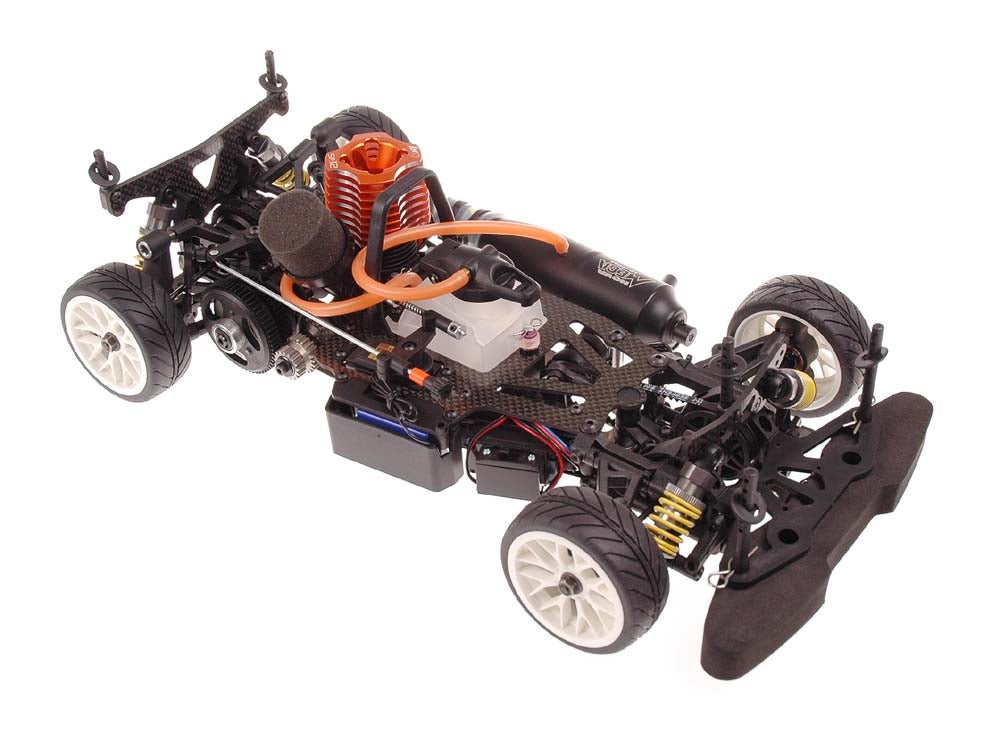
 "RamblinRover Luxury-Yacht" (ramblininexile)
"RamblinRover Luxury-Yacht" (ramblininexile)
03/03/2017 at 12:03, STARS: 1
If that doesnít count, we can invent a special category for it, Iíd say.
 "kanadanmajava1" (kanadanmajava1)
"kanadanmajava1" (kanadanmajava1)
03/03/2017 at 12:09, STARS: 1
Years ago my friend had a party. He promised prizes for the ones that would arrive with the largest and with the smallest engine. I decided to get a prize and took with me an extremely small Cox engine used for wire guided planes and one of my 1:10 nitro cars (just in case the aero engine wouldnít classify).
When were discussing if my small nitro engines could be counted, I realized that my daily driver Kadett C actually had the smallest engine of the all cars that were there. So the prize was mine.
 "Snuze: Needs another Swede" (markg)
"Snuze: Needs another Swede" (markg)
03/03/2017 at 12:10, STARS: 0
I completely understand where youíre coming from, and youíre right, there seems to be kind of a normal envelope for all this stuff but itís fun to see whoís pushing it. Also, I didnít realize the 289 was 4" bore block. For some reason I always thought they 3" stroke with a smaller bore. You learn something new every day.
 "JustJim" (JustJim)
"JustJim" (JustJim)
03/03/2017 at 12:26, STARS: 1
!!! UNKNOWN CONTENT TYPE !!!
 "CaptDale - is secretly British" (captdale)
"CaptDale - is secretly British" (captdale)
03/03/2017 at 12:30, STARS: 1
So my 1969 Austin Healey Sprite MKIV has the 1275 cc engine option. This was the end of the run for the Sprite, but the Midget continued on to have a 1500 cc.
Anyway the specs on the 1275:
Cylinders alignment:
Line 4
Displacement: 1275 cm3 / 77.7 cui
Bore: 70.61 mm / 2.78 in
Stroke: 81.28 mm / 3.2 in
Connecting Rod: Center to center length 146.05mm†
Compression ratio: 8.8 : 1
Horsepower net:48.5 kW / 66 PS / 65 hp (net) @ 6000 rpm
Torque net: 98 Nm / 72 ft-lb @ 3000 rpm
All this nets a top speed of 97 mph, 0-60 in 11.9 seconds, and the 1/4 mile in 18.6 seconds @ 73 mph
Incase you were wondering.
 "RamblinRover Luxury-Yacht" (ramblininexile)
"RamblinRover Luxury-Yacht" (ramblininexile)
03/03/2017 at 12:37, STARS: 1
Mmmmm, data.

Kind of funny how it still has a pretty long stroke as strokes go.
 "CaptDale - is secretly British" (captdale)
"CaptDale - is secretly British" (captdale)
03/03/2017 at 12:57, STARS: 0
Yup, very close to my GTO and 928. I mean they are all within the 3 inch area.
 "RamblinRover Luxury-Yacht" (ramblininexile)
"RamblinRover Luxury-Yacht" (ramblininexile)
03/03/2017 at 13:16, STARS: 1
Well, the first A-series was only four years after RAC horsepower went by the wayside, so a lot of that tradition was no doubt involved in their thinking. That first engine is neatly 3.65 RAC horsepower, and that was still a couple years before the French refined their (also broken) system, so Iíd assume it was 4CV tax category. In other words, the A-series isnít *hilariously* long-cylindered, but itís definitely coming from a tax hp-gaming mindset.
 "Die-Trying" (die-trying)
"Die-Trying" (die-trying)
03/03/2017 at 16:41, STARS: 0
i have a 305 that i put together for the bug.(4.030"bore x 3"stroke) scratch built the critter. its a round seal motor. i put 6 inch rods in it, and that gets it up to around 2:1 rod to stroke ratio.....
i was looking through some old auto magazines online a while back. it had a very interesting discussion on stroke found here . they built a 302, a 327, and a 350, with fairly evenly matched heads, and the top cams that the engines came with. SURPRISINGLY enough, they all made about the same power, just at different areas in the rpm range as a result of having the same bore, but different stroke.....
 "RamblinRover Luxury-Yacht" (ramblininexile)
"RamblinRover Luxury-Yacht" (ramblininexile)
03/03/2017 at 16:52, STARS: 1
Iím going to need to use 6" rods for my Rover 4.2 (3.03 stroke), so very similar except for a little smaller bore (3.73). The 4.2s originally had a tall non-directional piston, but Iím going to use a (shorter) piston for a later 4.0 to control compression, which has a different wrist diameter...
 "Die-Trying" (die-trying)
"Die-Trying" (die-trying)
03/03/2017 at 17:08, STARS: 0
are you going to manage to be using all off of the shelf parts? or are you going to need to end up ordering custom pistons?
in the 305 build, i didnt discover until later that the stock rods that went with the 3 inch stroke crank were a special 5.96 inch length, and that if i had taken the time to have sourced THOSE in the first place i would of been able to use off the shelf 350 pistons. i however CHOSE ahead of that to use 6 inch rods, and was then forced to get custom pistons in order to get a deck height that would work. hind sight and all that.....i am very pleased with what i built.
that ought to get you in near 265 cu inch right? what direction are you going to build this small motor? big valve high rpm, or small valve decent torque motor?.......
 "RamblinRover Luxury-Yacht" (ramblininexile)
"RamblinRover Luxury-Yacht" (ramblininexile)
03/03/2017 at 17:28, STARS: 1
Iíll have to make sure by measuring everything, but I think I can get it done with all off-the-shelf. That will depend on the width of SBC connecting rods vs. Buick 215/300/Rover ones, however, which I have not been able to verify yet. The early gen Rovers and the Buick 215/300 have small journals and small wristpins, and the late gen Rovers have big journals and big wristpins.
SBC conrods for an offset grind have the correct journal size and are within .007 of the correct wristpin size for a Rover 4.0/4.6 piston, so as long as I can get a width match, Iím golden, because the 4.0 piston + 6" rod is the right height. Otherwise, giant pain in the rear - they never made performance pistons for the 4.2, and only made a specialized slightly-shorter and offset version of the 3.9 piston and used a 3.9 rod. Summit stocks the SBC rods, so with any luck....
I have the early size mains as well, with the later style oil pump, so Iíve got oil for days... not going to puke out on that account like a 3.5 sometimes does.
The ci, depending on what I have to do with the liners, will probably be only a touch over the stock 262. The heads are the latest style with the largest valve available, and factory-shaved for composite gaskets, so I shouldnít have too much trouble with them - Iíve got porting diagrams for them.
The objective is to have an engine comfortable and peaking around 4.5k. It may be hard based on the heads, which have some limits, but Iím going to try. Revs, but not insanity, and not really going too nuts on the torque.
 "Die-Trying" (die-trying)
"Die-Trying" (die-trying)
03/03/2017 at 17:38, STARS: 1
that already looks like a fun build, just from the sound of it. do they make much in camshafts for rovers?with any luck, things ought to be close in the width of the rods.

 "RamblinRover Luxury-Yacht" (ramblininexile)
"RamblinRover Luxury-Yacht" (ramblininexile)
03/03/2017 at 18:28, STARS: 1
There are some pretty good cams available for not too much - enough people hop up the 3.5s that I can get the job done. I canít use a pure 4.0/4.6 (late type) cam because Iím using a dizzy - and the Bosch GEMS system doesnít use one.
I havenít even gotten into the silliness Iíll have to engage in to have accessory drive to only an alternator instead of an alternator and PS pump. It may even involve an electric water pump...
 "Die-Trying" (die-trying)
"Die-Trying" (die-trying)
03/03/2017 at 18:59, STARS: 0
youre going to ditch all the pulleys? or are you going to take a few pulleys , and stack them and weld them up so that you have more grooves to work with(v groove)? i remember seeing some set ups on serpentine, where they would have idlers, to keep the belts roughly the same length, but delete an accessory. or are you going to map out what direction each thing needs to turn, and then find a pulley for turning that direction? might have to make a string loop and take that to a parts house to get a belt if you went at it that way.
the small chevy had all kinds of wonderful variations on drive belts. i have seen more than a few franken-geneered to work.
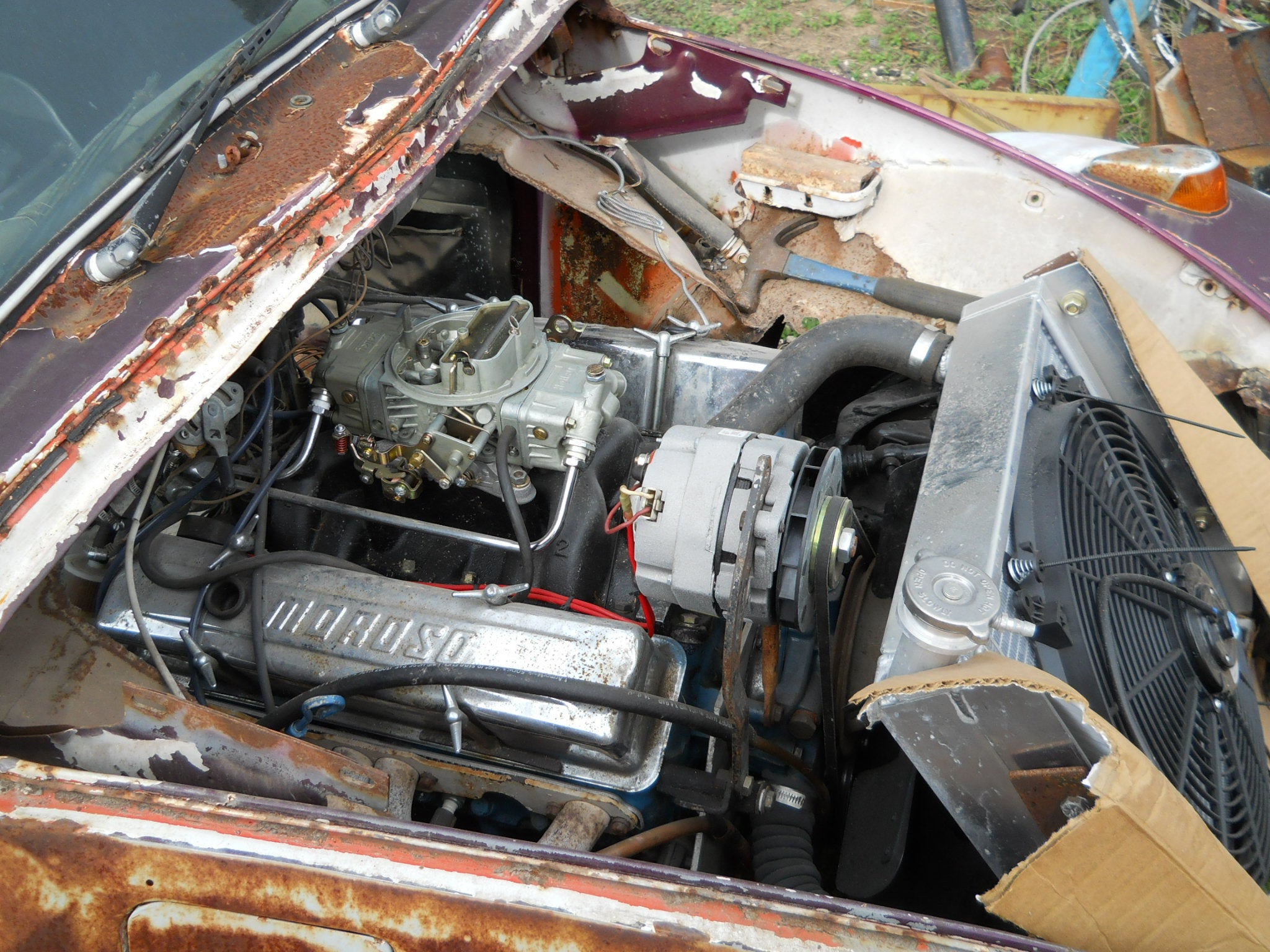
my friend helped me find enough bits and parts at his house to get things lined up, mounted, adjusted and working. when i was getting things together i made sure to keep it no accessories. made life easy when time to set up THE belt.
 "RamblinRover Luxury-Yacht" (ramblininexile)
"RamblinRover Luxury-Yacht" (ramblininexile)
03/03/2017 at 19:13, STARS: 1
I figured Iíd need to run V-belt only running the alternator and water pump, but the water pumps on these bastard things run backwards if theyíre the revised front cover. Over where the serpentine would run over the PS pump, I have... body. The shock tower - itís tight. So, my options are to find some idler-tastic abomination thing going on and alter my existing alternator, or something like an E-pump. If I do an e-pump, I might have to mill down the face of the timing cover about .125....
Canít use the old-style timing cover because it uses the inferior oil pump. Unless I did something really stupid with it, then, no old-style water pump. Kind of a conundrum, and thereís no off-the-shelf e-pump solution.
 "Die-Trying" (die-trying)
"Die-Trying" (die-trying)
03/03/2017 at 19:31, STARS: 0
could you make some spacers to ďshimĒ the old style water pump forward a hair bit to clear the updated timing cover and superior oil pump. maybe something like an aluminium plate that was say .250 inch thick? and just gasket both sides of it?.......

 "RamblinRover Luxury-Yacht" (ramblininexile)
"RamblinRover Luxury-Yacht" (ramblininexile)
03/03/2017 at 20:09, STARS: 1
Thatís a definite possibility - what makes it more complicated is that the timing cover has a recess in it in both cases. So, Iíd have to either fill with weld or mill down the timing cover and then monkey with the spacer.

Hereís a front view of a couple kinds:

Hereís from the back:
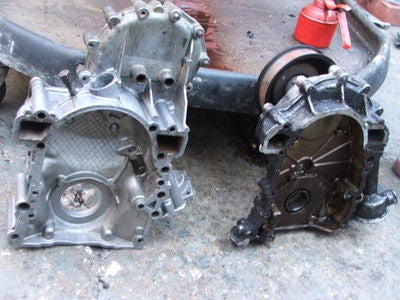
As you can see, the gerotor oil pump doesnít take up much space, but the pump setups are way different. I think Iím best off *not* trying to use the OE style v-belt pump if I can avoid it because itís a power sink, takes up space, and isnít efficient. Kind of ďehĒ.
 "Die-Trying" (die-trying)
"Die-Trying" (die-trying)
03/04/2017 at 21:36, STARS: 0
yeah, i can see where things would get silly in a hurry. the serpentine does look to be the way to go. you should be able to bridge with a few pulleys.....
